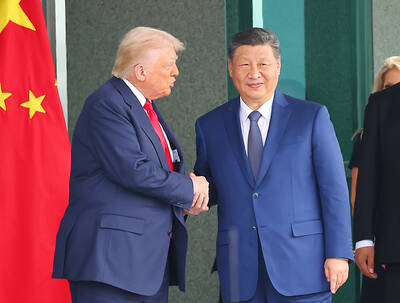The Chung-Hua Institution for Economic Research (CIER, 中華經濟研究院) yesterday raised its GDP growth forecast to 3.05 percent this year on a robust first-half performance, but warned that US tariff threats and external uncertainty could stall momentum in the second half of the year.
“The first half proved exceptionally strong, allowing room for optimism,” CIER president Lien Hsien-ming (連賢明) said. “But the growth momentum may slow moving forward due to US tariffs.”
The tariff threat poses definite downside risks, although the scale of the impact remains unclear given the unpredictability of US President Donald Trump’s policies, Lien said.

Photo: CNA
Despite the headwinds, Taiwan is likely to outperform many other economies, thanks to its central role in the global supply chain for artificial intelligence (AI)-related technologies, Lien said, adding that AI development would continue to provide economic support through the remainder of the year.
CIER estimates that GDP growth in the first half reached 5.17 percent, but would slow to just 1.08 percent in the second half, as front-loading of export orders weighs on future shipments.
Global firms have stockpiled inventories ahead of potential new US tariffs, which are set to take effect on Aug. 1 after several extensions, he said.
“We should remain cautiously hopeful,” Lien added, adding that negotiations with Washington might still take place even if tariffs are announced.
Recent economic data have outpaced expectations, with exports surging 34.1 percent in the second quarter year-on-year, despite what is typically a soft season, Directorate-General of Budget, Accounting and Statistics (DGBAS) official Wu Pei-shuan (吳佩璇) said.
On the domestic front, CIER expects private consumption to rise 1.57 percent and private investment to grow 7.03 percent this year, fueled largely by capital spending in AI and high-tech sectors.
Inflation is projected at 1.89 percent for the year — below the central bank’s 2 percent target — as a strong New Taiwan dollar helps suppress import prices.
However, food and service costs remain elevated, CIER researcher Peng Su-ling (彭素玲) said.
Every NT$1 appreciation of the local currency would reduce annual consumer price index growth by about 0.1 percentage point, according to the DGBAS.
CIER expects the NT dollar to rise from NT$32.89 per US dollar in the first quarter to NT$28.39 in the fourth quarter, as the US Federal Reserve is expected to cut interest rates twice before the end of the year, potentially weakening the greenback and attracting capital inflows to Asia.
If the US imposes a 10 to 15 percent tariff on Taiwanese goods, a depreciation of the NT dollar to about NT$30 could help absorb the impact, CIER economist Liu Meng-chun (劉孟俊) said, adding that the local currency might need to weaken to NT$35 if the tariff reaches 25 percent.

Nissan Motor Co has agreed to sell its global headquarters in Yokohama for ¥97 billion (US$630 million) to a group sponsored by Taiwanese autoparts maker Minth Group (敏實集團), as the struggling automaker seeks to shore up its financial position. The acquisition is led by a special purchase company managed by KJR Management Ltd, a Japanese real-estate unit of private equity giant KKR & Co, people familiar with the matter said. KJR said it would act as asset manager together with Mizuho Real Estate Management Co. Nissan is undergoing a broad cost-cutting campaign by eliminating jobs and shuttering plants as it grapples

TEMPORARY TRUCE: China has made concessions to ease rare earth trade controls, among others, while Washington holds fire on a 100% tariff on all Chinese goods China is effectively suspending implementation of additional export controls on rare earth metals and terminating investigations targeting US companies in the semiconductor supply chain, the White House announced. The White House on Saturday issued a fact sheet outlining some details of the trade pact agreed to earlier in the week by US President Donald Trump and Chinese President Xi Jinping (習近平) that aimed to ease tensions between the world’s two largest economies. Under the deal, China is to issue general licenses valid for exports of rare earths, gallium, germanium, antimony and graphite “for the benefit of US end users and their suppliers

Dutch chipmaker Nexperia BV’s China unit yesterday said that it had established sufficient inventories of finished goods and works-in-progress, and that its supply chain remained secure and stable after its parent halted wafer supplies. The Dutch company suspended supplies of wafers to its Chinese assembly plant a week ago, calling it “a direct consequence of the local management’s recent failure to comply with the agreed contractual payment terms,” Reuters reported on Friday last week. Its China unit called Nexperia’s suspension “unilateral” and “extremely irresponsible,” adding that the Dutch parent’s claim about contractual payment was “misleading and highly deceptive,” according to a statement

The Chinese government has issued guidance requiring new data center projects that have received any state funds to only use domestically made artificial intelligence (AI) chips, two sources familiar with the matter told Reuters. In recent weeks, Chinese regulatory authorities have ordered such data centers that are less than 30 percent complete to remove all installed foreign chips, or cancel plans to purchase them, while projects in a more advanced stage would be decided on a case-by-case basis, the sources said. The move could represent one of China’s most aggressive steps yet to eliminate foreign technology from its critical infrastructure amid a